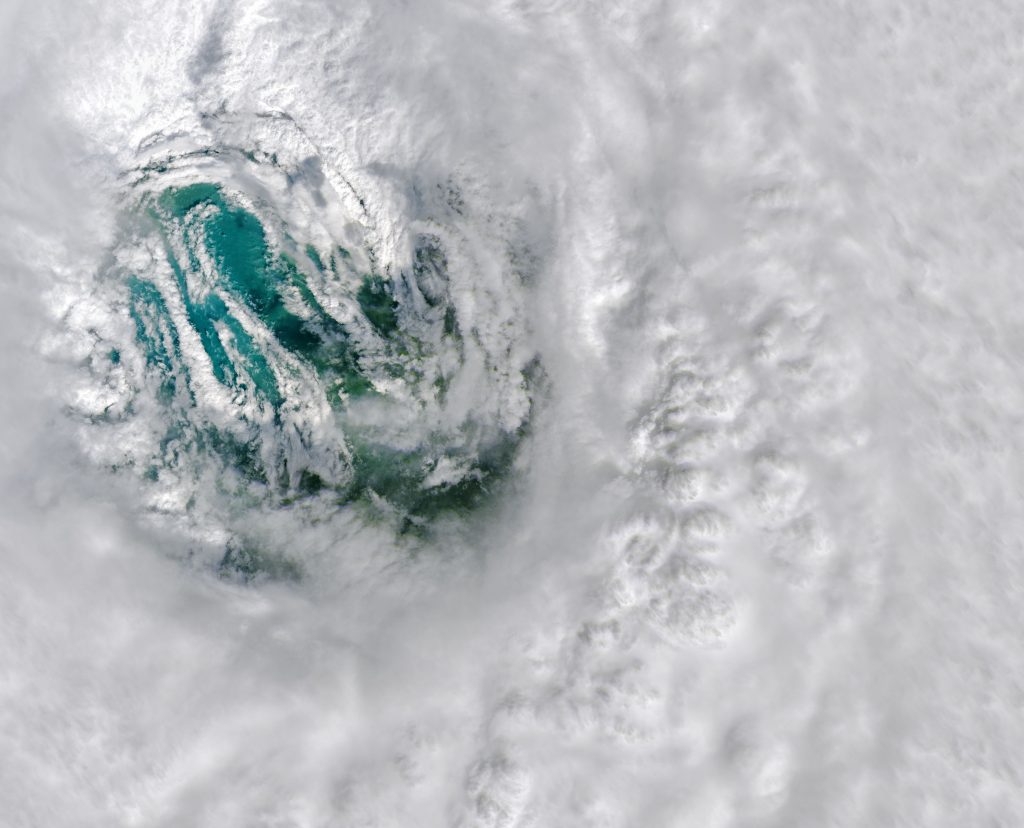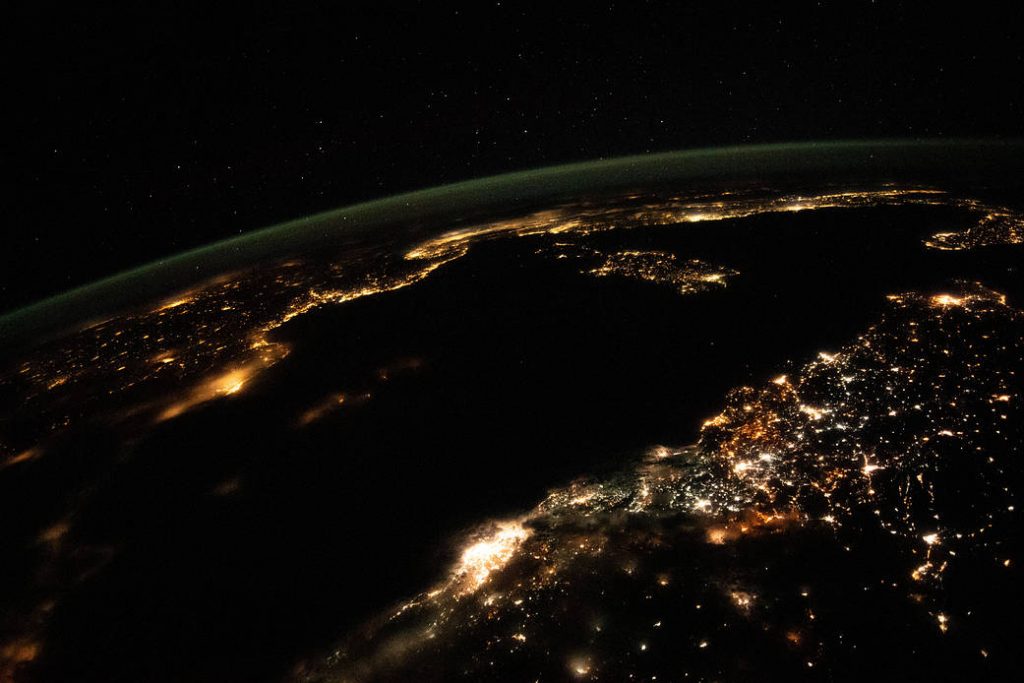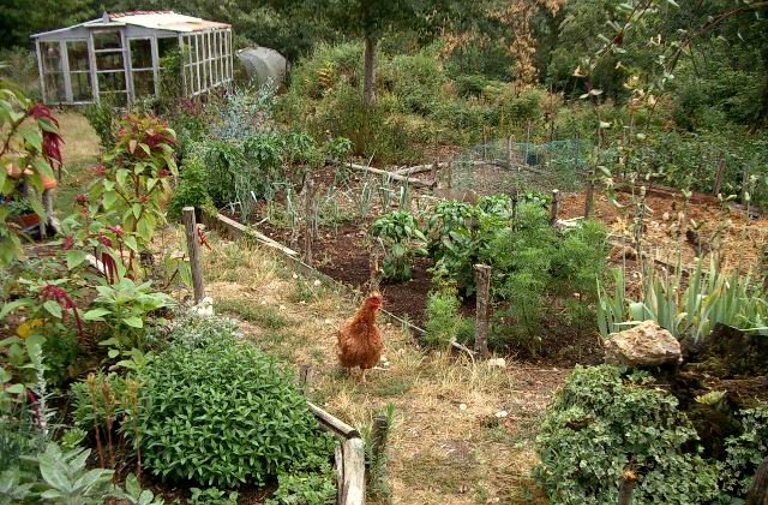This week’s reflection is by Tom Ellis, a retired English professor living in Oregon, a life-long environmental activist, holistic philosopher, and Gaian Buddhist. First printed on Medium, this essay definitely needed reposting here!
—

Gaia surrounded by a Moebius Band (Image by DALL-E)
Most dystopian fiction is set in the future, near or distant. But consider our present reality: a visibly accelerating rise in average global temperatures from year to year, leading to rapidly melting ice caps and glaciers, rising sea levels, the collapse of ecosystems, and the relentless pounding of unprecedented storms, droughts, floods, and wildfires worldwide; coupled with growing political and economic chaos and warfare, along with a rise in fascism and the fading of democratic ideals and corruption of institutions; and finally, the inexorable depletion of global fossil fuel reserves, promising a steady and accelerating rise in the prices of net energy — and therefore of everything else on the market. So the dystopian future is here, now. For this reason, I have decided to share my own dystopian fantasy, whose setting is not some imagined future, but right here and now.
Part I: The Gaia Movement Defined
So…imagine that somewhere, or in many places at once, a self-replicating Gaia movement were to start, whose adherents call ourselves, simply, “Gaians.” Unlike most others in our dying world, Gaians pledge our first allegiance not to any nation, flag, ideology, or religious creed, but rather to Gaia, our living planet. And imagine that we adopted for our unifying symbol something like the above image: an image of the living Earth, or Gaia, surrounded by a Moebius band, which embodies a mathematical, or topological paradox: a solid (you cut it out with scissors, then twist one end and tape it together) that nevertheless has only one side, not two. If you trace a pencil starting at any point on it, inside or out, your line will move effortlessly from the inside of the band to the outside and back again, without ever leaving the surface. And you can twist it in your hand so that any “inside” of the band becomes the ”outside” and vice versa.

The Gaian Logo
This is not the only symbol, of course. There are many others, such as the living Earth image all by itself, or a Solar Cross — a universal symbol of wholeness that can be found in nearly every other culture on the planet. Some excellent starting points for a worldwide Gaia movement already are available. My friend Erik Assadourian, for example, already has created a beautiful website called Gaianism, and has set up an E-list and ongoing set of Zoom-based virtual gatherings where fellow Gaians (like myself) from all over the planet can meet periodically and exchange essays, ideas, and links with one another.
Gaians differ from every other nationality, religion, or political ideology in one crucial respect: it is the only identity label I know that includes everyone (and all other living beings), excluding no one at all. So if I am a Gaian, so are you — whether you know it or not. A Gaian is any living being, human or otherwise, who inhabits this planet — the only living planet we will ever know first-hand — and who processes matter, energy, and information as an open system, taking in and recycling sunlight, water, air, and minerals in order to keep on keeping on. So we Gaians reject any artificial boundary between “humanity” and “nature.” Nature (or Gaia), is the system of which we are a part — not just a “resource” whose only value is to produce commodities — mineral or biological — for human consumption.
It’s important to note that Gaianism, or (my preferred term) Gaianity, is not a religion, per se, (although many may disagree with me on this, and I respect their views). That is, Gaian theory and Gaian consciousness have nothing at all to say about the classical religious questions, such as the nature of God; the origins and destiny of the universe, life, or humanity; sin, redemption, or the path to salvation. You don’t “have to believe” anything to be a Gaian; our thinking is firmly rooted in the scientific method: what we can, in principle, know or ascertain about our planet, our ecosystems, and our species — not what we can’t.

Staring into Ian’s eye reveals both the beauty and power of Gaia, as well as Gaia’s utter real-ness. (NASA Earth Observatory image by Joshua Stevens, using Landsat data from the U.S. Geological Survey.)
So one can be, without contradiction, a Gaian anything: a Gaian Buddhist (as I am), a Gaian Christian, a Gaian Jew, a Gaian Muslim, a Gaian Humanist, an Indigenous Gaian, or anything else. While we may have different religious beliefs, conscious Gaians share a common understanding of the following indisputable facts:
- That humanity is a part of, not apart from, nature (or Gaia)
- That nature (Gaia) is a life-sustaining holobiont, or complex adaptive system, that surrounds our entire planet, driven by solar energy, and consisting of self-sustaining and evolving interactions between the atmosphere, the hydrosphere, and the geosphere, all mediated by the biosphere, consuming and recycling energy in the form of sunlight, photosynthetic biomass, oxygen, carbon dioxide, decaying organic matter, microbes, and the mineral substrate (through topsoil).
- That all Gaians, humans included, consist of nested holarchies — systems within systems, starting with cells, moving on to organisms, organizations, communities, ecosystems, and finally the biosphere (Gaia) itself.
- That throughout our perennially evolving and deeply interconnected biosphere and noosphere alike, whatever affects one directly, affects all indirectly.
- That all living beings depend on the self-regulating stability of our global climate over time.
- That the current rapid changes to the climate and collapse of ecosystems, induced by anthropogenic CO2 and other pollutants, pose a direct and immediate threat to all complex, multicellular forms of life, ourselves included.
- Therefore, that economies based on the endless growth of production, consumption, and population are fundamentally incompatible with a finite living planet.
None of these claims can be refuted by any legitimate scientist. Therefore all reasonable people on the planet can potentially become active, conscious Gaians. So what are we waiting for?

We’re all connected via Gaia’s body, breath, and blood. (Image of looking across the Mediterranean from Northern Africa to Southern Europe by NASA)
Part 2: Imagine…
What might happen, starting today, if the Gaia movement went viral? That is, imagine if conscious Gaians started coming together and organizing themselves, both in person and virtually, in cities, towns, and villages throughout the world, with the shared agenda of awakening others to Gaian consciousness — to shifting their primary allegiance from tribe, corporation, political party, or nation upward to Gaia, the entire living Earth, and acting accordingly. How might this work? There are infinite possibilities, but here is one approach:
Gaian theory is complex, and difficult for the average person to grasp. Its founders, James Lovelock and Lynn Margulis, were both brilliant scientists with a deep command of systems thinking that few can even come close to matching.
Gaian praxis, however, is far more easily grasped; it has found its most complete expression in the worldwide permaculture movement, conceived in the late 1970s by Australian agronomist and visionary Bill Mollison and his student and colleague David Holmgren, both inspired by Lovelock’s Gaia theory. Permaculture is a generalized, teachable methodology for creating human habitats that are symbiotic with, rather than parasitic upon, Gaia, and it has been amazingly successful in healing landscapes in every bioregion on the planet.
The problem, of course, is that most people have not ever heard of either Gaia theory or Permaculture (although this is slowly changing, as both concepts have gradually found their way into the academic and cultural mainstream, often under new names such as “Earth Systems Science” and “Regenerative Agriculture”). But are there shortcuts to “mainstreaming” Gaian consciousness?
Although they may know little to nothing of Gaia theory, nearly all people now know about, and are terrified of, the climate crisis, even if they are still in denial. So this existential crisis we all face paradoxically makes it easier for people to start thinking globally. And while most people have never heard of Permaculture, nearly everyone enjoys fresh, local fruits and vegetables out of their own, or their neighbor’s, garden.
So imagine Gaians coming together and forming autonomous neighborhood Garden Guilds, everywhere they live. A Garden Guild is a voluntary association of contiguous neighbors who meet periodically to share home-grown fruits, vegetables, and ideas about gardening, and — as they get to know each other, share tools and labor as well. And imagine the garden guilds in any community going on to form networks, where they can exchange ideas with one another about growing their own food, and other projects they undertake. The organizing slogan for the Garden Guild initiative is this: Grow Gardens, Grow Community, Grow Awareness — through Learning Gaia, Teaching Gaia, Healing Gaia, and Creating Gaia.
Briefly,
Learning Gaia means learning everything we can about living systems and our living planet, starting in our backyards and expanding outward to our immediate watersheds, bioregions, et al. But since we are a part of nature, it also means learning all we can about human evolution, human history (in relationship to Gaia), collective human behavior, community-building, and change agency, and — at the practical level, learning permaculture design skills — how to grow our own food sustainably, and build symbiotic, rather than parasitic relationships with our landscapes and communities, and how to master the skills we need to become more self-reliant. In short, Learning Gaia means cultivating our own and others’ health, competence, and resilience in all things.
Teaching Gaia means teaching others any or all of the above, on an ongoing basis, to everyone we can reach…
Healing Gaia means getting involved with Earth care, People Care, and Fair Share in whatever ways we can, depending on our knowledge, skills, and interests — from Permaculture design to environmental advocacy.
Creating Gaia means using whatever creative gifts we have, whether through music, art, gardening, website design, craftsmanship, writing, organization building, or whatever else we do well to create a Gaian culture from the ground up…
Now, imagine Garden Guilds — now becoming Gaian Guilds — proliferating like wildflowers all over the planet, even in the face of accelerating global catastrophes, propagating an ethos of collective self-reliance, compassion, and cooperation, and thereby gradually emancipating themselves from Glomart (our toxic global market economy) by cultivating the Eight Forms of Capital: not just financial capital, but also material, biological, experiential, intellectual, social, cultural, and spiritual capital, and sowing the seeds of a regenerative Gaian future upon the smoldering or flooded ruins of Glomart.
May it only happen…

Gaia in the Milky Way, lit up by lightning (Image from NASA/Kjell Lindgren)
Teaser photo credit: By hardworkinghippy : La Ferme de Sourrou – Garden chicks and herbs, CC BY-SA 2.0, https://commons.wikimedia.org/w/index.php?curid=91838010





